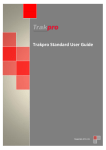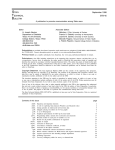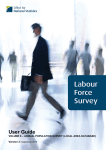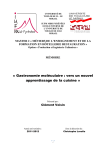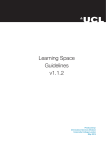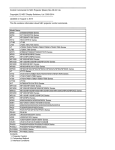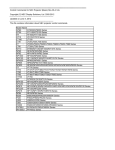Download Social capital: introductory user guide
Transcript
Social capital: introductory user guide ESDS Government Author: C. Hall, Office for National Statistics Updated by: Necla Acik-Toprak Version: 1.5 Date: November 2011 G6 The series of ESDS Guides are available online at www.esds.ac.uk 1 This guide has not been updated since September 2012 The Economic and Social Data Service (ESDS) became a part of the UK Data Service on 1 October 2012. Guides written by ESDS Government are no longer being updated as of the end of September 2012. For up to date information about registration with the UK Data Service, data and documentation, information about how to use the data including guides and help pages, please see the UK Data Service website: www.ukdataservice.ac.uk You can also subscribe to the mailing list: https://www.jiscmail.ac.uk/cgi-bin/webadmin?A0=UKdataservice G6 The series of ESDS Guides are available online at www.esds.ac.uk 2 Introduction Social capital research informs the extent to which people are civically engaged and their level of trust. High social capital in the form of social networks is suggested to lead to a variety of outcomes including economic growth and educational attainment. Employed individuals with extensive social contacts have been shown to progress further (Halpern, 2005)1. Although it is claimed that social capital can have an impact in terms of better health outcomes there is yet insufficient evidence to state that social capital is a causal factor. This document provides a summary of the key aspects of government surveys conducted in the UK where information collected includes some aspect of social capital (see Table 2). All major government surveys and some key non-government surveys are included. The list under ‘Large-Scale Social Capital Surveys’ separates those supported by the Economic and Social Data Service (ESDS) and those that are not. Background to social capital measurement Social capital is a multi-faceted concept that embodies networks and norms. In 2003 a cross-governmental working group agreed to adopt the OECD definition of social capital across government departments. This is “networks together with shared norms, values and understandings that facilitate co-operation within or among groups”. Social capital has been described as having three main types: bonding, bridging and linking. Bonding social capital - describes close connections between people and is characterised by strong bonds, e.g. among family members or close friends; it is good for “getting by” in life. Bridging social capital - describes more distant connections between people and is characterised by weaker, but more cross-cutting ties, e.g. with business associates, acquaintances, friends of friends or those of a different ethnic group or social class; it is good for “getting ahead” in life. Linking social capital - describes connections with people in positions of power and is characterised by relations between those within a hierarchy where there are different levels of power; it is good for accessing support from formal institutions. This is concerned with relations between people who are not on an equal footing e.g. job searching at the Job Centre. To support the measurement of social capital the Office for National Statistics (ONS) identified the key dimensions that underpin it: views about the local area (e.g. satisfaction with living in the area, problems in the area, fear of crime) civic participation (e.g. propensity to vote, action on local and national issues) social networks and support (e.g. contact with friends and relatives) G6 The series of ESDS Guides are available online at www.esds.ac.uk 3 social participation (e.g. involvement in groups and voluntary activities) reciprocity and trust (e.g. trusting other people, trust in the courts or police) These form the framework for a question set developed specifically to support central and local government surveys. Social Capital Harmonised Question Set (HQS) The process of harmonisation involves the use of standard questions and outputs with common classifications and definitions for key concepts. In 2001 it was identified that government surveys were including questions on social capital but a variety of approaches were being used. In some surveys the questions had the specific intention of measuring social capital while in others they did not. In 2003 the Office for National Statistics published a set of questions that are recommended by the cross-governmental working group for measuring social capital. The aim was to bring greater consistency to the measurement of social capital, allowing for comparison between data sources and the aggregation of data from disparate sources. It also allows the comparison of national and sub-national survey data. The questions were developed to capture core aspects of social capital. Using information from the social capital question bank (see link below) as a base, a draft set of questions was developed. A pilot of the proposed questions, which incorporated both bridging and bonding, was run on the NS Omnibus survey in May, June and July 2003. Bridging questions were not included in the final HQS as further development work was needed on them. The HQS has been adopted either fully or partially since its development in the following surveys: Survey of English Housing (selected questions) Home Office Citizenship Survey 2005 (core) General Household Survey Trailer 2004/05 (full) Health Survey for England older focus questions 2005 (selected questions) Families and Children Survey Wave 7 (2005) (core) Full details on each of these surveys are provided in Table 2. Work is progressing on a postal version of the core HQS in conjunction with the National Centre for Social Research (NatCen). Further details on the Harmonised Question Set can be found in the following ONS papers: G6 The series of ESDS Guides are available online at www.esds.ac.uk 4 Social Capital Indicators2 Development of the Harmonised Questions3 See also The Social Capital Project.4 Large-Scale Social Capital Surveys The following section lists large-scale surveys that include questions on dimensions of social capital. These are shown as those supported by ESDS Government5, those supported by ESDS Longitudinal6 and others. ESDS Government British Social Attitudes/Scottish Social Attitudes/Northern Ireland Life and Times Survey British Crime Survey/Scottish Crime Survey/Northern Ireland Crime Survey General Household Survey/Continuous Household Survey Health Survey for England Survey of English Housing UK Time Use Survey ESDS Longitudinal British Household Panel Survey English Longitudinal Study of Ageing Understanding Society7 Others Breadline Britain/Poverty and Social Exclusion Survey/Bare Necessities: Poverty and Social Exclusion in Northern Ireland British Election Study Citizen Audit Questionnaire English House Condition Survey Families and Children Survey Scottish Household Survey Health Education Monitoring Survey Northern Ireland Health and Social Well-being Survey G6 The series of ESDS Guides are available online at www.esds.ac.uk 5 Citizenship Survey National Adult Learning Survey Samples of Anonymised Records (SARs) Taking Part: The National Survey of Culture, Leisure and Sport Youth Lifestyles Survey/Offending Crime and Justice Survey Useful links Australian Bureau of Statistics – Social Capital pages8 Survey Question Bank9 ESDS Government: survey-specific web pages 10 ESDS Government: Publications Database11 National Centre for Social Research12 Office for National Statistics – The Social Capital Project13 OECD – Human and Social Capital14 Siena Group15 Social Capital Gateway16 Economic and Social Data Service17 British Household Panel Survey The British Household Panel Survey (BHPS) began in 1991. It is run by the Institute for Social and Economic Research at the University of Essex and funded by the Economic and Social Research Council (ESRC). The BHPS was designed as a research resource for a wide range of social science disciplines. It was planned that the data would be used to further understanding of social and economic change at both the individual and household level. Initially it was designed for GB coverage and was extended to the UK in 2001. It is unique in design in that it: follows the same representative sample of individuals over a period of years is household-based, interviewing every adult member of sampled households contains sufficient cases for meaningful analysis of certain groups such as the elderly or lone parent families G6 The series of ESDS Guides are available online at www.esds.ac.uk 6 Sample sizes Wave 1 (1991): 5,500 households (10, 300 individuals) drawn from GB 1999: 1,500 households added in both Wales and Scotland 2001: 2,000 households added from Northern Ireland The sample was drawn from the Small User Postcode Address File. All residents present at the first wave are designated as panel members. These individuals are re-interviewed each successive year and, if they split off from original households and form new households, they are followed and all adult members of the new households are also interviewed. New adults joining the sample households are eligible for interview and children are interviewed once they reach age 16. Full details of the relevant social capital elements can be found in Table 1. Table 1: Rotating core topics on BHPS Topic Crime Local services and facilities Voting questions Whether voted in last election Attitudes to government Trust Neighbourhood Social networks Social support Social and interest group membership and activity Leisure activity including some on community Waves 7, 12, 17 8, 13, 18 All waves 2, 5, 7-13, 14, 15, 16, 17, 18 2, 4, 6, 8, 11, 13, 16 8, 10, 13, 15, 17, 18 8, 13, 14, 15, 16, 17, 18 2, 4, 6, 8, 10, 12, 14, 15, 16, 17, 18 1, 3, 5, 7, 9, 11, 13, 15, 16, 17, 18 1-5, 7, 9, 11, 13, 15, 17 6, 8, 10, 12, 14, 17 For more details on the British Household Panel Survey18 see the Institute for Social and Economic Research pages at the University of Essex. G6 The series of ESDS Guides are available online at www.esds.ac.uk 7 From Wave 19, the BHPS will be subsumed into a new longitudinal study called Understanding Society19, or the United Kingdom Household Longitudinal Study (UKHLS), conducted by ISER. The BHPS Wave 19 will be part of Understanding Society Wave 2 (January 2010 - March 2011). General Lifestyle Survey (formerly General Household Survey) – Social Capital Trailers and EU-SILC The General Household Survey (GHS)20 is a multi-purpose continuous survey carried out by the Office for National Statistics. It is sponsored by the Office for National Statistics and a variety of government departments. The main aim of the survey is to collect data on a range of core topics, covering household, family and individual information. It is therefore a useful data source for linking social capital data with other topics, such as employment, family information or health. Methodology The GHS started in 1971 and has been carried out continuously since then, except for breaks in 1997-1998 when the survey was reviewed, and 1999-2000 when the survey was redeveloped. Following the 1997 review, the survey was relaunched from April 2000 with a different design. There have been a number of methodological changes to the GHS since its start in 1971, including: the small users Postcode Address File (PAF) replaced the Electoral Registers as the sampling frame in 1984 since 1988 the survey has been based on the financial year rather than calendar year but returned to the calendar year in January 2006 until 1994 a supplementary sample of addresses was selected in Scotland to improve estimates in separate analyses for Scotland since 1994 interviews have been conducted using computer-assisted personal interviewing (CAPI) on laptop computers following recommendations from the 1997 review of the GHS, a number of significant methodological changes took place from 2000 onwards, including changes to the sample design, alternative methods of data collection, questionnaire content and the introduction of weighting. To meet the requirements of EU data collection, the GHS is now used to collect information for the EU-SILC (European Union Survey of Income and Living Conditions). One of the main features of this is the need for the GHS to supply both cross-sectional and longitudinal data. This requirement has resulted in a change to the GHS sample design to a four-yearly rotation, an increase in sample size and additional core questions. The GHS began data collection for EU-SILC in April 2005. Further information about the methodology of the GHS can be found in Appendix B of the GHS online reports21. Overview of questions The survey consists of two elements: a set of core questions that are included every year and a set of non-core questions (“trailers”) that are included at certain intervals, for example, every two years or every five years. The 1997 review of the GHS resulted in the core questions remaining unchanged for the five-year period April 2000 to March 2005, apart from essential changes to take account of, for example, changes G6 The series of ESDS Guides are available online at www.esds.ac.uk 8 in benefits or pensions (see the Living in Britain22 and Survey Question23 on Bank web sites for further details). The core element consists of a household questionnaire to be answered by the Household Reference Person (Appendix A of the 2002 report24 gives a detailed definition) or spouse and an individual questionnaire to be completed by all adults aged 16 or over resident in the household. In 2000 a social capital trailer was run on the GHS. This included questions on the local area, fear of crime, participation and trust. The trailer was funded by the Health Development Agency as part of a larger body of work to further understanding of social capital in terms of its meaning, measurement and links to health within the British population. The social capital module was also a step in the development of the harmonised question set. In 2004/05 the full HQS was run as a trailer on the GHS. This is the first time the full HQS has been run on a large scale survey. In 2006, as part of EU-SILC, a module on cultural and social participation was included on the GHS. This includes questions on cultural participation (e.g. attendance at the cinema and sporting events), how often friends and relatives are seen/spoken to and membership of clubs. The Citizenship Survey The Citizenship Survey (formerly known as the Home Office Citizenship Survey or HOCS) has been conducted on a biennial basis from 20012011. The survey provides an evidence base for the work of Communities and Local Government (formerly the Department for Communities and Local Government), principally on the issues of community cohesion, community engagement, race and faith, volunteering and civil renewal, and is also used extensively for developing policy and for performance measurement. The achieved sample size each year is approximately 10,000 adults in England and Wales (plus an additional boost sample of 5,000 adults from minority ethnic groups). In 2003 there were supplementary booster samples of children (eight and nine-year-olds), young people (10 to 15-year-olds), and 20 local areas. In 2005 the core harmonised question set on social capital was included on the HOCS. Since 2007, the survey has moved to a continuous design, allowing the provision of headline findings on a quarterly basis. These headline findings are being issued through a Statistical Release. Detailed reports based on the entire annual dataset are also to be published once a year. Further information about the survey and links to the statistical releases25 can be found on the Communities and Local Government Citizenship Survey26 web pages. Further information is also available from the ESDS Citizenship Survey pages27. The Citizenship has been cancelled in 2011 due to budgetary cuts28. G6 The series of ESDS Guides are available online at www.esds.ac.uk 9 Table 2: Summary of large-scale surveys containing social capital data This table details the survey name, key social capital questions and the years they were asked (where relevant) and other topics the survey covered. Under the Survey section there are links to survey information, the most recent questionnaire and the data, when this is available. The remaining columns detail in which year each survey was conducted, the target respondents for the survey, the number of respondents to the survey and what coverage the survey data is available for. Survey Breadline Britain Data29 (1990 data unavailable at present) Poverty and Social Exclusion Survey30 Data31 Social capital questions Access to necessity and luxury items Perceptions of poverty Perceptions of poverty Social networks and support Other topics in survey Access to services (e.g. libraries) Employment Health Income Demographics Housing Health Time poverty Necessities Finance and debts Intra-household poverty Poverty over time Absolute and overall poverty Area deprivation Local services Crime Child's school G6 The series of ESDS Guides are available online at www.esds.ac.uk Measurement over time 1983, 1990 1999 Designed as update to Breadline Britain Respondents Sample Adults aged over 16 living in private households Great Britain In 1983 1,174 adults Adults aged 16 and over living in private households In 1990 1,319 adults plus 512 adults living in deprived areas Great Britain 1,534 interviews achieved Geographical level National Countries Standard Regions For detail on selection see weighting and grossing section 10 Bare Necessities – poverty and social exclusion in Northern Ireland32 Perceptions of poverty Community support (Module A) Modules A or B randomly assigned to individuals in household British Crime Survey33 Data34 Scottish Crime and Justice Survey35 Link to 2009-10 questionnaire36 Fear of crime Perceptions of anti social behaviour Social capital module included since the 2001/02 survey, includes questions on neighbourhoods and civic participation Views on social issues Fear of crime Views of respondent's locality Demographics Income Necessities and economising Opinions on standard of living Intra-household living standards Health and disability Economic activity Income Assets and debt Demographic information Household and personal experience of crime Levels of crime Household and personal experience of victimisation Contact with the police Demographics Experience of Domestic Abuse (self-completion questionnaire) G6 The series of ESDS Guides are available online at www.esds.ac.uk Two surveys carried out between June 2002 and January 2003 1. identification of ‘necessities’ 2. numbers of households lacking theses necessities Waves carried out in 1982, 1984, 1986, 1988, 1992, 1994, 1996, 1998 and 2000. From 2001 it became an annual survey. In 1982 and 1988 the Crime Survey in Scotland formed part of the British Crime Survey (BCS) the Scottish part of the 1988 BCS All household members aged 16 and over Northern Ireland Northern Ireland 1,425 interviews achieved Adults aged 16 and over in private households England and Wales In 2008-09 Standard regions Police Force Areas (for limited questions only) 46,286 cases (non-victim form); 16,184 cases (victim form) Variations in different years. e.g. the 2000 survey had an ethnic boost. Older surveys included children but Scotland 2006: Non-victim file: 4,988 cases. Victim file: 2,596 cases. For 2006: Police Force Area, Acorn, Mosaic, Urban-rural indicator (8category). 11 Northern Ireland Crime Survey37 Fear of crime Perceptions of anti-social behaviour Perceptions of experiencing a crime British Election Political citizenship Self-reported drug misuse (self-completion questionnaire) Victimisation among a sample of young people was also known as the Scottish Areas Crime Survey. In 1993 the first independent Scottish Crime Survey was carried out. It was repeated in 1996, 2000 and 2003. In 2004 the survey was redesigned and renamed the Scottish Crime and Victimisation Survey. In 2008, it was renamed the Scottish Crime and Justice Survey. more recent surveys interview one randomly selected adult in each household. Experience of personal and household crime Crime and personal safety The police, police monitoring arrangements and the criminal justice system Experience of illicit drugs Experience of domestic violence Surveys in 1994/95, 1998, 2001 and 2003/04 One adult aged 16 or over per household Main topics: G6 The series of ESDS Guides are available online at www.esds.ac.uk Northern Ireland 2003/04: 3,104 adults Continuous survey from January 2005 Run at every 3 regions: Belfast, East of Northern Ireland, West of Northern Ireland. Urban / Rural indicator. Aged 18 and Great Britain Standard regions 12 Study38 2005 Questionnaire39 (based on face-to-face component of survey) Data40 Based on question in 2001. In 2005 additional questions asked on Social network effects Civic duties British Household Panel Survey41 Questionnaires waves 1-1842 Data43 Civic engagement Section on Values and Opinions in Individual questionnaire: Neighbourhoods Reciprocity Participation Trust Political preference and values Economic perceptions Social attitudes Dispositions to engage in different forms of political activity Individual and household socio-demographic characteristics Core questionnaire Household composition Housing conditions Residential mobility Education and training Health and the usage of health services G6 The series of ESDS Guides are available online at www.esds.ac.uk general election since 1964 over - one randomly selected adult in each household Full questionnaire asked annually since 1991 Panel study therefore same group of individuals interviewed each year. Social capital questions are part of the The 2005 BES comprised a series of linked studies. • The British Election Study pre-election cross-section survey • The British Election Study pre-election internet survey • The Rolling Campaign Panel survey • The British Election Study post-election panel and cross-section survey • The British Election Study post-election internet survey. Great Britain 1991 onwards United Kingdom 2001 onwards Local Authority Districts Counties Unitary Authority Areas 13 Labour market behaviour Socio-economic values Income from employment, benefits and pensions ‘rotating core’ of See Table 1 above for more details. All household members 16 and over In 1994 A Youth self-completion element added – children aged 11 – 15 British Social Attitudes44 Link to 2008 questionnaire45 Data46 Political attitudes Political participation Social trust The survey covers a wide range of social, moral and political issues. Some topics are covered every or nearly every year (for example, taxation and spending, the NHS, politics, labour market participation, the welfare state, religion). Other topics are covered less regularly (for example, marriage, gender roles, national identity) G6 The series of ESDS Guides are available online at www.esds.ac.uk Annually since 1983 Exceptions in 1988 and 1992 when funding went to the British Election Study One randomly selected individual (aged 18+) in each sampled household. Wave 1 base was 5,500 households in GB In 1999 an additional 1,500 households added in both Wales and Scotland. In 2001 a sample of 2,000 households added in Northern Ireland. Great Britain Government Office Regions Achieved 4,468 individuals in 2008. In 1997 a scaled down version of BSA done in conjunction with the British 14 Scottish Social Attitudes47 Varies depending on year, for example: Link to 2007 questionnaire48 2004: Views of local area Democracy and participation Social support Environmental justice in local area Social trust Data49 As British Social Attitudes, with additional Scottish modules such as views on the devolved administration. 2003 Political trust 2002 Democracy and participation Views of local area Election study for continuity Began in 1999 as an annual Scottish sister survey to the British Social Attitudes survey. Annually since then. Persons aged 18 years and over resident in Scotland, including north of the Great Glen. Scotland Achieved 1,508 adults in 2007 2006: urban-rural variables Generally: Postcode Districts, Local Authority Areas and Parliamentary Constituencies. From 2000 wards are included and in 2002 the Scottish Household Survey (SHS) 6-fold urban-rural classification. From 2004 wards will no longer be available on dataset. 2001 Caring 2000 Social capital module Democracy and participation Voluntary activity 1999 Political trust G6 The series of ESDS Guides are available online at www.esds.ac.uk 15 NI Life and Times (NILT) Survey50 Link to 2009 questionnaire51 Link to NILT datasets from ARK52/ESDS53 2009: Political behaviour and attitudes; Social attitudes and behaviour; Leisure, tourism and sport 2008: Political behaviour and attitudes; Social attitudes and behaviour Questions on Background Community relations and Political attitudes are asked every year. Information on other topics asked each year can be found here54. Northern Ireland Life and Times survey began in 1998. This was based around the Northern Ireland Social Attitudes Survey that ran from 1989 to 1986. One randomly selected individual (aged 18+) in each sampled household. Northern Ireland All UK residents United Kingdom Northern Ireland 2009: 1,228 obtained interviews 2007:Political attitudes, Trust in public services 2006: Political attitudes 2005: Political participation 2001:Social networks Census 2001 Questionnaires: England and Wales55 Scotland56 Northe57rn Ireland Data58 1998: Crime and fear of crime Caring Individual questionnaire: Q12 – E&W Q17 – Scotland Q12 – N Ireland Demographic information Household composition Housing Employment G6 The series of ESDS Guides are available online at www.esds.ac.uk 2001 only. Inclusion in 2011 to be decided 16 Citizen Audit Questionnaire59 Data60 English House Condition Survey61 Attachment to local area Satisfaction Trust Participation Local environment Trust (2004-05) Data 198662 (ESDS) Political interests European Monetary system Media Demographic characteristics Interview Survey: Household characteristics Satisfaction with home and area Property details Physical survey -completed on house by qualified surveyor after interview Data 199163 – (Data from 1991 onwards on the ODPM website) Market value survey -two market valuations of the property provided English Longitudinal64 Included in Waves 1 and 2: Private landlord survey - interview with landlord of those privately renting Demographics (households and G6 The series of ESDS Guides are available online at www.esds.ac.uk One off in 2001 including panel follow up UK residents aged 18 and over. Great Britain Local Authorities Face to face component – 3,140 Standard regions Panel reinterview component – 804 1986, 1991, 1996, 2001, Run continuously from 2002 to April 2008 when it was integrated with the Survey of English Housing to form the new English Housing Survey (EHS) Households and dwellings Wave 0 1998, 1999, 2001 Core sample: Representative Mail back component – 8564 England England 2006 – achieved sample was 16,269 households (or 15,648 dwellings) England At present the ELSA team are not 17 Study of Ageing Questionnaires65 Data66 Families and Children Study68 (previously Survey of LowIncome Families) Questionnaire69 Informal care giving Membership of organisations Social and civic participation Wave 3: Social participation Voluntary work Memberships of organisations Social networks/support View of local area Family support networks Participation Control Caring Neighbourhood The core HQS is being asked in 2005 individuals) Income and assets Pensions Employment Housing Material consumption Physical and mental health Cognitive function Expectations for the future Family characteristics Schooling Children’s physical activity Education Local services for children Child maintenance payments Childcare Deprivation G6 The series of ESDS Guides are available online at www.esds.ac.uk Waves 1-4 20022009 Wave 1 (baseline data): July to September 1999 Wave 2: June to October 2000 Wave 3: September 2001 sample of those aged 50 and over (born on or after 29/02/52) living in private households. Also: Younger partners (cohabiting spouses or partners) of core sample member at time of HSE interview Original sample based on Health Survey for England (1998, 1999 and 2001) New partners: (cohabiting spouses or partners) of the core sample member who were not there at the HSE interview but were present at ELSA interviews ‘Mother figure’ in household Wave 3: 9,771 participants For Waves 5 and 6 a selfcompletion questionnaire was administered to Wave 1 12,100 participants Wave 2: 9,433 participants Great Britain depositing any variables which will allow analysis by or on spatial units. However, in certain circumstances these data can provided to researchers who want to use it. Details of how to obtain access to these data are given in the User Guide for Geographical Variables67, from the ELSA documentation at ESDS National Refreshed Panel sample - panel from 1999 reinterviewed in subsequent years. Sample 18 Data70 (1999-2005) - January 2002 children 11-15 Wave 4: September 2002 - January 2003 boosted each wave for additional crosssectional elements. Wave 5: 2003 Wave 5: 7,293 respondents Wave 6: 2004 Wave 7: 2005 General Household Survey71 2000/01 Social Capital Module 2004/05 HQS Link to 2006 questionnaire72 Data73 2006 EU-SILC (European Union Survey of Income and Living Conditions) Social and cultural participation Module. Incorporating pan-EU comparable longitudinal design. See Eurostat74 web site. Education, Employment, Health Household and family information, Housing tenure Consumer durables, Smoking Drinking Pensions; and many others 1972-2004 Time-series dataset75 available. G6 The series of ESDS Guides are available online at www.esds.ac.uk Annually from 1971 (except for breaks in 1997/98 when the survey was reviewed and 1999/2000 when it was redeveloped). The 1971 data is not downloadable from ESDS and is only available in ASCII. Significant methodological changes from 2000 onwards. In 2005 the survey changed and introduced a longitudinal component All individuals aged 16+ resident in the sampled household. Great Britain Achieved 9,700 households (23,000 individual interviews) in 2006. 2006: Government Office Region (GOR) 19 Scottish Household Survey77 Survey topics78 Data79 Continuous Household Survey80 Questionnaires81 Data82 Health Education Monitoring Survey84 Data85 Aspects of local neighbourhood Local participation / volunteering From Jan 2005 additional questions added on Volunteering Neighbourhood perception (antisocial behaviour) Social capital Module in 2003/04 Opinion of local area Social networks Participation Demographic Information Driving and transport Young people in household Health and disability Household income and employment Household finances Family information Household composition Education Employment Health And many others. Module Included in 2005/06 questionnaire For a full list of topics each year see here83. Social support Civic engagement General health The environment The elderly Skin cancer Smoking G6 The series of ESDS Guides are available online at www.esds.ac.uk (GHS-L/EUSILC). The 2006 dataset is the first to contain this data (see ESDS study description)76. Commissioned 1998 Data available from 1999- 2008 Households and one random adult within the household Scotland 2003/2004 Main survey: 30,013 householders Local authority areas every 2 years Travel diary: c15,618 householders CHS began in 1983 Social Capital module in 2003/04 and 2005/06 1995 – 1998 Then discontinued All individuals aged 16+ resident in the sampled household. Northern Ireland Adults in private households aged 16 and over England 2005/06: 2,656 households 6,733 individuals Northern Ireland Country level, no specific spatial unit level variables for confidentiality reasons National In 1998 5,800 adults 20 Health Survey for England86 Questionnaire87 Data88 Neighbourhood characteristics Trust Family and friends Informal social networks Participation Drinking Physical activity Nutrition Classification questions Sexual behaviour Focuses on different demographic group or disease condition and its risk factors and looks at health indicators such as Cardiovascular disease Physical activity Eating habits Accidents Asthma Smoking Drinking Full survey 1991 - present 2000 a Social capital module was included on HSE Mid – 2001 a shortened version was placed on the survey and administered every year 2005 an extended module focussing on older people in the field. This has additional Social Capital questions Northern Ireland Health and Wellbeing Survey91 In Social Environment section of main questionnaire Rating of neighbourhood Main questionnaire: General health Lifetime incidence common ailments Physical activity G6 The series of ESDS Guides are available online at www.esds.ac.uk 1997 and 2001, 2005-6 England Adults in private households 16 and over Children aged 215 included since 1995 Children aged 01 included since 2001 See also Scottish Health Survey89; Welsh Health Survey90 Household interview followed by individual interviews with The sample for 2006 was designed to be a crosssection of the population living in private. The achieved sample size for 2008 was 22,623 cases in the individual file (all individuals who gave a full-interview) and 31,927 cases in the household file (all individuals in cooperating households). Northern Ireland. In 2005, 4245 individuals 2008: Government Office Region, Strategic Health Authority; Urban/rural indicator (8 categories); Index Multiple Deprivation (grouped into 5 categories) NI Health Board Area 21 Link to 2005-06 questionnaire92 Link to data93 Social interaction Control over life In Self completion: Social Support Scale all adults aged 16 and over. Stress In self completion: Parenting Sexual health In 1997, 2435 households, 4236 individuals, of whom 1713 gave physical measurement s. Other: Smoking Drinking Citizenship Survey94 2008-09 data95 2003 Active community participation Local neighbourhood Trust Unpaid help / volunteering Charitable giving These are in the self completion for those aged 16 and 17, and in the face to face for adults Demographic information Family Employment Racial prejudice and discrimination Religious beliefs Rights and responsibilities In 2005 the core harmonised question set is part of the HOCS questionnaire In 2001, 3006 households and 5205 individuals. 2001, 2003 and 2005 the survey was known as the Home Office Citizenship Survey (HOCS). In 2007 it became the Citizenship survey and moved to a continuous design. Core sampleadults aged 16 and over and minority ethnic boost sample 2003 only: children (eight and nine year olds) and young people (ten to fifteen year olds) England and Wales 2008-09 2008-09 Government Office Region ODPM Index of deprivation 14,917 people (core sample and a minority ethnic boost) The 2008-09 survey covered: identity and social networks feelings about the community, G6 The series of ESDS Guides are available online at www.esds.ac.uk 22 National Adult Learning Survey96 Data97 Survey of English Housing98 Questionnaire99 Data100 including community cohesion trust and influence volunteering civic engagement race and religious prejudice, and perceptions of discrimination religion mixing between people of different backgrounds values demographic and some geodemographic information 2001 questions: Participation Social engagement Local area satisfaction Experience of full time education Highest qualifications achieved Any other learning Basic skill Computer and internet use Core topics: Tenure Housing costs Housing history Moving intentions Separate module for private tenants: G6 The series of ESDS Guides are available online at www.esds.ac.uk 1997, 2001, and 2002. 2001 only: social capital included Began in 1993. Continuous survey with data released yearly In April 2008 the Survey of English Housing (SEH) merged Adults aged 1669 living in private households England and Wales Government Office Regions Families, and households. Interviews carried out with HRP and their spouse/partner England England 2004/05 18,386 households Government Office Region, Standard Statistical Region, LA code 2002 6,668 individuals 1930 tenancy group interviews 23 Tenancy type Rent Housing benefits Demographic information Broadcasting Gambling Internet with the English House Condition Survey (EHCS) to form the new English Housing Survey (EHS).101 Annual survey which started in 2005/6 Taking Part: The National Survey of Culture, Leisure and Sport102 Volunteering Local area Trust Participation / attendance in sports opportunities, arts opportunities, heritage, museums and galleries, libraries and archives UK Time Use Survey103 Volunteering Caring for others Social activities Diary of all activities on one week day and one weekend day. Individual and household information also collected 2000 only Youth lifestyle survey 1992/93 & 1998/99 Questionnaire104 Aged 16 and over All individuals aged 8+ in the sampled household. Data105 The Youth Lifestyles Survey Data106 Participation Socialisation Offending Schooling Employment Income Family life G6 The series of ESDS Guides are available online at www.esds.ac.uk Young people aged 12 – 30 living in private households England Continuous survey comprising each year approximately: 27,000 adults 1,500 boost among black and minority ethnic groups United Kingdom GOR Regions Acorn 8 point urban/rural Government Office Region Achieved 6,414 households in 2000/1. England and Wales Local Authority Standard regions 4,848 individuals 24 Offending Crime and Justice Survey107 Data108 Neighbourhood section: Local area Trust Safety in area / crime Participation Social networks Housing Attitude to sentencing and justice system Experience with the police Demographics Attitudes Victimisation Anti-social behaviour Fraud and technology Offending Drinking behaviour Drug use Health, lifestyle and risk factors Reactions to survey First wave in 2003 (10 to 65s). Subsequent waves in 2004, 2005, 2006 (10 to 25s only). Rotating panel sample Nationally representative sample of individuals living in private households (1065s in 2003; 1025s in 20042006) England and Wales 2003: 10,085 core sample respondents aged 10-65; booster sample so that 4577 respondents aged 10-25; additional ethnic minority booster sample of 1886 PFA Government Office Region Although these area variables are on the dataset the numbers are likely to be too low to do robust analysis at area level. 2004: Two thirds of the 5,000 young people interviewed in 2003 received a follow up interview in 2004 2005 and 2006: G6 The series of ESDS Guides are available online at www.esds.ac.uk 25 Follow up interviews with 10 to 25s Weighting and Grossing The information given below gives an example of the weighting used within each survey which covers social capital topics. The example given within each survey is not necessarily the latest dataset available from ESDS. You should refer to the survey documentation on the ESDS web site109 for the specific year(s)/datasets(s) you are interested in, as the weighting may change slightly from year to year. Bare Necessities: Poverty and Social Exclusion in Northern Ireland No weighting variable was used. British Crime Survey The BCS has been weighted since 1982. The survey has a number of different weights which should be applied in different circumstances, see the BCS 2004 User guide Vol. 1110 for a full list of weights. There are three main reasons for weighting the BCS; (1) to compensate for unequal selection probabilities; (2) to compensate for differential response rates; (3) to ensure that quarters are equally weighted for analyses that combine data from more than one quarter. British Election Study In 2001 weights were used in this survey to create a nationally representative sample. A separate weight is used for each section of the survey. For the Pre-Election baseline survey this is AWGTGB and will produce a pre-election nationally representative sample. For the Post-Election survey (or the traditional BES) applying POSTOCTW will produce a post-election nationally representative sample. In the Pre-Post Election Panel Survey element BPANWGT will give a nationally representative sample and for the Post Back Mail Questionnaire MAILWGT is the weight applied. See the BES 2001 web site111 for more details. British Household Panel Survey There are separate weights for each wave of the data. In general, there are separate weights for respondent individuals, for all enumerated individuals and for households. The appropriate weight to use will depend on the level of the analysis. Proxy and telephone respondents have zero respondent weights, but positive enumerated individual weights. There are cross-sectional weights for use with the single wave analyses of each wave. G6 The series of ESDS Guides are available online at www.esds.ac.uk 26 These weights should not be used for longitudinal analysis, the last set of longitudinal weights from the most recent wave should be used. Thus if using waves 1 to 11, the longitudinal weighting from wave 11 would be used. Cases that are enumerated or have responded up to and including the latest wave will have relevant positive longitudinal weights at that wave. At Wave 9 cross-sectional weights were added for the Scottish and Welsh supplements, longitudinal weights were made available for these sub-samples at Wave 10. With the addition of a Northern Ireland sample at Wave 11 new UK wide weights were added, UK longitudinal weights followed at Wave 12. It is possible to analyse each country alone or together with the use of respectively the UK1 or UK2 weights. Please see the ISER web site112 for more information. See the Technical Notes on the ESDS web site113 for more information about the BHPS. British Social Attitudes The main dataset (in common with all surveys based on samples from the Postcode Address File) must be weighted to take account of differing selection probabilities. Households are selected with equal probability, but only one person in each household is interviewed. People in small households therefore have a higher probability of selection than people in large households and the weighting corrects for this. Please note that the data must be weighted in all analyses. The file is not pre-weighted. Before running any analysis, use the SPSS command weight by wtfactor. The BSA has been weighted since 1983. The 2002 survey has one sample design weight (Wtfactor) used to compensate for unequal selection probabilities (because only one person per household is interviewed). See the BSA 2004 User Guide114. Continuous Household Survey No weighting used. Grossed estimates are produced based on the mid-year population estimates115. English House Condition Survey The EHCS is a stratified sample with weights to address the sampling structure, non-response and grossing to national estimates for dwellings and households. Details on sampling and grossing can be found in the technical annex to the report on the Communities and Local Government web site116. English Longitudinal Study of Ageing The variable in the dataset to be used for weighting is w1wgt. Weights were calculated for the core sample members only (including proxy and partial interviews), as this was the sample of interest. All other non-sample individuals that were interviewed (i.e. new and younger partners) have a weight of zero. When running weighted analyses, researchers should remember to exclude non-sample members in the unweighted base, if quoted. The data for partners can be used as characteristics of the core members (i.e. supplementary information). See the User Guide117 for more information. G6 The series of ESDS Guides are available online at www.esds.ac.uk 27 Families and Children Survey (FACS) The FACS contains weights for both cross-sectional and longitudinal research. Grossing weights are supplied summating to sample numbers (fGROSSW) and to administrative numbers for population estimates (fGROSSP). Prior to the 2001 wave, FACs contains a representative sample of ‘low to moderate income families’, defined in relation to benefit receipt of Family Credit, Working Family Tax Credit (WFTC), or Working Tax Credit. Further details are provided (see online documentation). For waves 2001 to 2004, a larger sample reflecting all families (and not just low-moderate income ones) is represented. Consequently, longitudinal weights reflect these sample differences. In the 1999-2004 dataset, there is a ‘longitudinal weight for all families’ which can be used for looking at waves 3-6 (2001 onwards) with a base of all families with dependent children for the 2001 sample (fLWAF). A further ‘longitudinal weight for original families’ (fLWOF) is included providing a panel weight for the original families from the 1999 dataset (i.e. low to moderate income families). Online 118documentation can be found on the ESDS web site. General Household Survey Since 2000, a dual weighting scheme has been introduced to the GHS. The dataset contains one weighting variable for two purposes, (1) to compensate for non-response in the sample, and (2) to gross up to match known population distributions in terms of region, age-group and sex. The 2002-2003 weighting variable is called Weight01. See Appendix D in the 2002 GHS report119 for more information. Health Education Monitoring Survey The weighting factors used are number of adults aged 16 years and over in household, age, gender and region (living in South East or not). Health Survey for England Weighting variables are year specific owing to differing sample design and the survey topic each year. For example, in 2000 weights are added for different probabilities of selection in care homes - see the 2000 User Guide120. In 2002, no weights need to be applied if only using the adult general population sample or the boost sample of 16-24 year olds on its own. However, if using the boost sample of 16-24 year olds together with the adult general population sample, a sample design weight which accounts for unequal probabilities of selection needs to be applied (tablewt). The HSE data will be weighted from 2003 onwards for non-response. See the 2003 User Guide121. For all children’s data (1995 onwards), a child weight needs to be applied to account for unequal selection probabilities. Also see the 2004 User Guide122 for further information. Citizenship Survey In 2001 weights were applied to the whole sample to take account of the over-representation of minority ethnic groups. Weighting was also applied to the core sample to correct for unequal selection probabilities and to compensate for differential non-response among some G6 The series of ESDS Guides are available online at www.esds.ac.uk 28 population sub-groups. See the 2001 Technical Report123 for full details. In 2003 weights were applied to the core and whole sample as in 2001. There was an additional stage of weighting in 2003 that ensured that both samples matched the population figures in terms of their age, sex and regional distribution. Further information can be found in the 2003124 and 2005125 Technical Reports available on the ESDS website. National Adult Learning Survey The 2002 data has several weights. The data is weighted to correct for different household selection probabilities (wt1), for different selection probabilities within the household (wt2) and to correct for non-response (wt3). There are no weights to correct for the number of courses undertaken. There were three points in the survey where there was a possibility of follow up questions; in these circumstances weights have been calculated to correct for questions that follow-up randomly selected items (wt4, wt5 and wt6). In addition a composite weight was calculated (weight = wt1 x wt2 x wt3) to correct for different household selection probabilities, different selection probabilities and non-response. This can be used for analysis at an individual level. See the 2002 Technical report126 for more information. Northern Ireland Crime Survey This survey was weighted to account for unequal likelihood of selection in larger households as only one individual per household was interviewed. Northern Ireland Health and Wellbeing Survey The 2001 survey does not include weights because a simple random sample of addresses was selected. However, a weight was required in 1997 because the survey was designed to select equal samples from each of the Four Health and Social Services Board, which meant that overall the survey would not accurately reflect the Northern Ireland population. Weighting adjusts the results to those that would be achieved if the sample had been drawn as a random sample of addresses in NI. A weight was also required for the physical appraisal element of the 1997 study. Only one adult was selected from each household for the physical measures, therefore individuals living in large households had a lower chance of being included in the sample than individuals in small households. This weighting process adjusts the results to those that would have been achieved if the sample had been drawn as a random sample of adults rather than addresses. Thus, the 1997 dataset contains two weights (Indvni and Physni). More information is available in the 1997 User Guide127. Northern Ireland Life and Times Survey The main dataset (in common with all surveys based on samples from the Postcode Address File) must be weighted to take account of differing selection probabilities. Households are selected with equal probability, but only one person in each household is interviewed. People in small households therefore have a higher probability of selection than people in large households and the weighting corrects for this. G6 The series of ESDS Guides are available online at www.esds.ac.uk 29 Please note that the data must be weighted in all analyses. The file is not pre-weighted. Before running any analysis, please use the SPSS command weight by wtfactor. The survey has been weighted since 1983. The 2002 survey has one sample design weight (Wtfactor) used to compensate for unequal selection probabilities. See the Technical Notes128 for more detail. Scottish Household Survey There are four weights in the 2003 SHS dataset. LA_WT adjusts for differences in sampling fractions and response rates between local authorities and should be used when analysing household, household member and vehicle variables. IND_WT is the individual weight to be used when analysing Random Adult data. KID_WT is the individual weight used to analyse Random Schoolchild data. RANKIDWT contains the weight to be used when analysing the random child data. See the 2003 User Guide129 for more information. Scottish Social Attitudes The main dataset (in common with all surveys based on samples from the Postcode Address File) must be weighted to take account of differing selection probabilities. Households are selected with equal probability, but only one person in each household is interviewed. People in small households therefore have a higher probability of selection than people in large households and the weighting corrects for this. The SSAS has been weighted since 1983. The 2002 survey has one sample design weight (Wtfactor) used to compensate for unequal selection probabilities (because only one person per household is interviewed). Since the 2003 survey, there are also weighting factors for urban and rural addresses: WtFactor (whole sample), WtRural (to analyse rural addresses), WtRemote (to analyse remote addresses) and WtUrban (to analyse urban addresses). The SSA 2004 User Guide130 explains this in more detail. Survey of English Housing The SEH has been weighted since 1994/95 to produce population estimates and to compensate for different response rates among households. The 2001/02 dataset has two weight variables (H4d and H4dt), both of which combine weights for non-response and grossing: (1) h4d - weights for non-response and grosses to households in England (in 000s); (2) h4dt - weights for non-response and grosses to tenancy groups in England (in 000s). See the 2001/02 User Guide 2131 for more information. Poverty and Social Exclusion Survey A final weight (wt4) should be used when analysing the data. It is made up of four elements: a weight for country, a weight for income quintiles, a weight for probability of selection and a non-response weight. The PSE interviewed one person per household, oversampled households in Scotland and oversampled households in the lowest quintile groups of equivalised income. Several weights were calculated for this and used to create the wt4 variable: Wt1 - weighting for country; Wt2 - weighting for income group; Wt3a – c are used to take account of household size. See the 1999 User Guide132. G6 The series of ESDS Guides are available online at www.esds.ac.uk 30 Time Use Survey The TUS uses weighting for a variety of reasons. There are different weights on the different files (individual questionnaire file, worksheet file, household questionnaire file and diary file). For more information go to the Time Use 2000 User Guide.133 There are two individual questionnaire weights: both weights compensate for non-response and are calibrated to UK population characteristics for age-group, sex and region. The difference between the two weights is that one grosses to the UK population and the other does not. wtpq_ug is the ungrossed weight which weights to the achieved sample size, wtpq_gr is the grossed weight which weights to UK population of those aged 8 years or more living in private households. There are two worksheet weights, as individual weights, wtwrk_ug is ungrossed and wtwrk_gr is grossed. There are two diary weights, as individual weights but also compensates for differential sampling of weekdays and weekends, wtdwh_ug is ungrossed weight and wtdwh_gr is grossed. There are six household questionnaire weights, as individual weights but two separate weights for each of following: households with dairy-keepers: (1) wtdh_ug is ungrossed; (2) wtdg_gr is grossed households with worksheet-keepers: (3) wtwh_ug is ungrossed; (4) wtwg_gr is grossed households with diary and worksheet-keepers: (5) wtdh_ug is ungrossed; (6) wtdg_gr is grossed (from health guide) Youth Lifestyles Survey/Offending Crime and Justice Survey 1) Youth Lifestyles Survey 1998-99 For analysis in this survey a weight (finalwgt) has been constructed to correct for five elements: (i) over representation of inner-city residents; (ii) cases where there was more than one dwelling at the PAF address; (iii) under-representation of individuals living in households with more than one resident aged 12 – 30; (iv) over-sampling in high crime rate areas; (v) non-response. For the Computer Assisted Self Interview questions on offending a sixth factor is corrected for – age – as response rates differed by age for these questions (wgtofndr). When undertaking analysis of the CASI offending questions the weight to use is called ‘wgtofndr’. When undertaking any other analyses use the weight ‘finalwgt’. See the 1998-99 User Guide134 for more information. 2) Offending, Crime and Justice Survey 2003 onwards The 2003 OCJS uses two series of weights, one designed for the combined core and youth boost samples and the other for the non-white boost sample. These are documented more fully in the Technical Report. G6 The series of ESDS Guides are available online at www.esds.ac.uk 31 Young person sample - most of the steps involved for the core sample were repeated for the young person boost sample. One difference is that inability to identify non-responding young people means we cannot estimate a non-response model, however, the profile of the core sample members aged 10-25 was used to indicate the magnitude of the weights likely to be appropriate for the boost sample. Combined core sample - the core 10-65 and young person 10-25 boost samples were combined. The weights derived from the steps described above were optimised by comparing the weighted samples within Government Office Regions, using a 14-category breakdown by age, repeated for male and female respondents. The comparator was the 2001 Census profile for the GOR. An iterative process was employed to optimise the cell weights applied to the sample, in order to minimise the overall magnitude of the weighting adjustments. Details of this stage of weighting are given in Appendix F. The refinements to the weights resulting from this process were applied to the original core sample weight (variable Wt_Core). This may be used for all analysis of the combined core sample and the boost sample of young people. Non-White boost sample - a similar procedure was applied for the cases in the non-white boost sample. Initially, the non-white members of the core youth boost and non-white boost samples were individually weighted to the profile of the respondents in the core sample. The three groups were then separately scaled so that the weighted number of cases was equal to the number of achieved interviews. At this stage they were combined and the same process of weighting to the census profile within Government Office Regions. The appropriate weight for analysis of the non-White boost sample is variable ‘Wt_Eth’. 1 David Halpern (2005) Social Capital. Cambridge: Polity Press. http://www.ons.gov.uk/ons/publications/re-reference-tables.html?edition=tcm%3A77-233195 3 http://www.ons.gov.uk/ons/guide-method/harmonisation/secondary-set-of-harmonised-concepts-and-questions/index.html 4 http://www.ons.gov.uk/ons/guide-method/user-guidance/social-capital-guide/the-social-capital-project/index.html 5 http://www.esds.ac.uk/government/surveys/ 6 http://www.esds.ac.uk/longitudinal/access/introduction.asp 7 http://www.esds.ac.uk/longitudinal/access/usoc/L33423.asp 8 http://www.abs.gov.au/websitedbs/c311215.nsf/0/3af45bbd431a127bca256c22007d75ba?OpenDocument 9 http://surveynet.ac.uk/sqb/ 10 http://www.esds.ac.uk/government/surveys/ 11 http://www.esds.ac.uk/government/citations/ 12 http://www.natcen.ac.uk/ 13 http://www.ons.gov.uk/ons/guide-method/user-guidance/social-capital-guide/the-social-capital-project/index.html 14 http://www.oecd.org/document/24/0,3746,en_2649_39263294_2380248_1_1_1_1,00.html 2 G6 The series of ESDS Guides are available online at www.esds.ac.uk 32 15 http://unstats.un.org/unsd/methods/citygroup/sienna.htm http://www.socialcapitalgateway.org/ 17 http://www.esds.ac.uk/ 18 http://www.iser.essex.ac.uk/bhps 19 http://www.understandingsociety.org.uk/default.aspx 20 http://www.esds.ac.uk/government/ghs/ 21 http://www.ons.gov.uk/ons/search/index.html?pageSize=50&newquery=General+Household+Survey+2007+Report+ 22 http://www.ons.gov.uk/ons/rel/ghs/general-household-survey/2001-edition/index.html 23 http://surveynet.ac.uk/sqb/ 24 http://www.ons.gov.uk/ons/search/index.html?pageSize=50&newquery=General+Household+Survey+2002+Edition+-+Living+in+Britain%3A+Full+Report++ 25 http://www.communities.gov.uk/communities/research/citizenshipsurvey/quaterlystatisticalreleases/ 26 http://www.communities.gov.uk/communities/research/citizenshipsurvey/ 27 http://www.esds.ac.uk/findingData/hocsTitles.asp 28 http://www.communities.gov.uk/communities/research/citizenshipsurvey/surveycancellation/ 29 http://www.esds.ac.uk/findingData/snDescription.asp?sn=1865 30 http://www.bris.ac.uk/poverty/pse/ 31 http://www.esds.ac.uk/findingData/snDescription.asp?sn=4349 32 http://www.csu.nisra.gov.uk/survey.asp20.htm 33 http://webarchive.nationalarchives.gov.uk/20110218135832/http://rds.homeoffice.gov.uk/rds/bcs1.html 34 http://www.esds.ac.uk/findingData/bcrsTitles.asp 35 http://www.esds.ac.uk/findingData/scsTitles.asp 36 http://www.esds.ac.uk/doc/6685%5Cmrdoc%5Cpdf%5C6685_scjs_2009-10_full_final_quest.pdf 37 http://www.csu.nisra.gov.uk/survey.asp8.htm 38 http://www.bes2009-10.org/ 39 http://www.essex.ac.uk/bes/2005/Survey%20Documents/bes%20technical%20report%20plus%20internet%202007.pdf 40 http://www.esds.ac.uk/findingData/besTitles.asp 41 http://www.iser.essex.ac.uk/bhps 42 http://www.iser.essex.ac.uk/bhps/documentation/pdf_versions/survey_docs/index.html 43 http://www.esds.ac.uk/findingData/bhpsTitles.asp 44 http://www.esds.ac.uk/Government/bsa/ 45 http://www.esds.ac.uk/doc/6390/mrdoc/pdf/6390questionnaires.pdf 46 http://www.esds.ac.uk/findingData/bsaTitles.asp 47 http://www.esds.ac.uk/government/ssa/ 48 http://www.esds.ac.uk/doc/6262/mrdoc/pdf/6262userguide.pdf 49 http://www.esds.ac.uk/findingData/ssasTitles.asp 16 G6 The series of ESDS Guides are available online at www.esds.ac.uk 33 50 http://www.esds.ac.uk/government/nilts/ http://www.esds.ac.uk/doc/6546/mrdoc/pdf/6546userguide.pdf 52 http://www.ark.ac.uk/nilt/datasets/ 53 http://www.esds.ac.uk/findingData/niltTitles.asp 54 http://www.ark.ac.uk/nilt/results/searchmod.html 55 http://www.ccsr.ac.uk/esds/ons-mirror-august-2011/465/www.statistics.gov.uk/census2001/pdfs/H1.pdf 56 http://www.gro-scotland.gov.uk/files/indform.pdf 57 http://www.unece.org/fileadmin/DAM/stats/census/2000/files/United%20Kingdom/Northern%20Ireland/2001%20Individual.pdf 58 http://census.ac.uk/ 59 http://www.esds.ac.uk/doc/5099/mrdoc/pdf/5099userguide.pdf 60 http://www.esds.ac.uk/findingData/snDescription.asp?sn=5099 61 http://www.communities.gov.uk/housing/housingresearch/housingsurveys/englishhousecondition/ 62 http://www.esds.ac.uk/findingData/relatedStudyListForSN.asp?sn=6106 63 http://www.communities.gov.uk/housing/housingresearch/housingsurveys/englishhousecondition/ehcsdatasupporting/ehcspublicdatasets/ 64 http://www.esds.ac.uk/longitudinal/access/elsa/l5050.asp 65 http://www.esds.ac.uk/findingData/snDescription.asp?sn=5050#doc 66 http://www.esds.ac.uk/findingData/snDescription.asp?sn=5050 67 http://www.esds.ac.uk/doc/5050%5Cmrdoc%5Cpdf%5C5050_User_Guide_for_Geographical_Variables.pdf 68 http://www.esds.ac.uk/findingData/snDescription.asp?sn=5050 69 http://research.dwp.gov.uk/asd/asd5/facs/facs_questions.asp 70 http://www.esds.ac.uk/findingData/snDescription.asp?sn=4427 71 http://www.esds.ac.uk/government/ghs/ 72 http://www.esds.ac.uk/doc/5804%5Cmrdoc%5Cpdf%5C5804interviewdocs.pdf 73 http://www.esds.ac.uk/findingData/ghsTitles.asp 74 http://epp.eurostat.ec.europa.eu/portal/page/portal/eurostat/home/ 75 http://www.esds.ac.uk/findingData/snDescription.asp?sn=5664 76 http://www.esds.ac.uk/findingData/snDescription.asp?sn=5804 77 http://www.scotland.gov.uk/Topics/Statistics/16002 78 http://www.scotland.gov.uk/Topics/Statistics/16002/TopicsList 79 http://www.esds.ac.uk/findingData/shsTitles.asp 80 http://www.csu.nisra.gov.uk/survey.asp2.htm 81 http://www.csu.nisra.gov.uk/survey.asp30.htm 82 http://www.esds.ac.uk/findingData/chsTitles.asp 83 http://www.csu.nisra.gov.uk/survey.asp27.htm 84 http://www.esds.ac.uk/findingData/snDescription.asp?sn=4137 51 G6 The series of ESDS Guides are available online at www.esds.ac.uk 34 85 http://www.esds.ac.uk/search/indexSearch.asp?ct=xmlSn&q1=%2033294 http://www.ic.nhs.uk/statistics-and-data-collections/health-and-lifestyles-related-surveys/health-survey-for-england 87 http://surveynet.ac.uk/sqb/surveys/hse.asp 88 http://www.esds.ac.uk/findingData/hseTitles.asp 89 http://www.esds.ac.uk/findingData/shlsTitles.asp 90 http://www.esds.ac.uk/findingData/whsTitles.asp 91 http://www.csu.nisra.gov.uk/survey.asp5.htm 92 http://www.esds.ac.uk/doc/5710%5Cmrdoc%5Cpdf%5C5710userguide.pdf 93 http://www.esds.ac.uk/search/indexSearch.asp?ct=xmlSn&q1=33332 94 http://www.communities.gov.uk/communities/research/citizenshipsurvey/ 95 http://www.esds.ac.uk/doc/6388/mrdoc/pdf/6388questionnaires.pdf 96 https://www.education.gov.uk/publications/standard/publicationDetail/Page1/RR321 97 http://www.esds.ac.uk/search/indexSearch.asp?ct=xmlSn&q1=33327 98 http://www.communities.gov.uk/housing/housingresearch/housingsurveys/surveyofenglishhousing/ 99 http://www.communities.gov.uk/housing/housingresearch/housingsurveys/surveyofenglishhousing/sehtechnicalinformation/ 100 http://www.esds.ac.uk/search/indexSearch.asp?ct=xmlSn&q1=33277 101 http://www.communities.gov.uk/housing/housingresearch/housingsurveys/englishhousingsurvey/ 102 http://webarchive.nationalarchives.gov.uk/+/http://www.culture.gov.uk/reference_library/publications/5653.aspx/ 103 http://www.ons.gov.uk/ons/search/index.html?pageSize=50&newquery=%27The+United+Kingdom++2000+Time+Use+Survey%27 104 http://www.esds.ac.uk/doc/4504/mrdoc/pdf/4504userguide2.pdf 105 http://www.esds.ac.uk/findingData/snDescription.asp?sn=5536 106 http://www.esds.ac.uk/findingData/snDescription.asp?sn=4345 107 http://webarchive.nationalarchives.gov.uk/20110218135832/http://rds.homeoffice.gov.uk/rds/offending_survey.html 108 http://www.esds.ac.uk/findingData/snDescription.asp?sn=6000 109 http://www.esds.ac.uk/ 110 http://www.esds.ac.uk/findingData/snDescription.asp?sn=5347#doc 111 http://www.essex.ac.uk/bes/data.html 112 http://www.iser.essex.ac.uk/bhps 113 http://www.esds.ac.uk/findingData/snDescription.asp?sn=5151 114 http://www.esds.ac.uk/doc/5329/mrdoc/pdf/5329userguide.pdf 115 http://www.nisra.gov.uk/demography/default.asp17.htm 116 http://www.communities.gov.uk/housing/housingresearch/housingsurveys/englishhousecondition/ 117 http://www.esds.ac.uk/findingData/snDescription.asp?sn=5050 118 http://www.esds.ac.uk/findingData/snDescription.asp?sn=4427&key=families+and+children#doc 119 http://www.ccsr.ac.uk/esds/ons-mirror-august-2011/571/www.statistics.gov.uk/downloads/theme_compendia/lib2002.pdf 86 G6 The series of ESDS Guides are available online at www.esds.ac.uk 35 120 http://www.esds.ac.uk/doc/4487/mrdoc/pdf/a4487uab.pdf http://www.esds.ac.uk/doc/5098/mrdoc/pdf/5098userguide.pdf 122 http://www.esds.ac.uk/doc/5439/mrdoc/pdf/5439userguide.pdf 123 http://webarchive.nationalarchives.gov.uk/20110218135832/http://rds.homeoffice.gov.uk/rds/pdfs04/hocstechreport.pdf 124 http://www.esds.ac.uk/doc/5087/mrdoc/pdf/5087userguide.pdf 125 http://www.esds.ac.uk/doc/5367/mrdoc/pdf/5367userguide.pdf 126 http://www.esds.ac.uk/doc/4681/mrdoc/pdf/4681userguide.pdf 127 http://www.esds.ac.uk/doc/4589/mrdoc/pdf/a4589uab.pdf 128 http://www.ark.ac.uk/nilt/datasets/technotes.html 129 http://www.esds.ac.uk/doc/5020/mrdoc/pdf/5020userguide.pdf 130 http://www.esds.ac.uk/doc/5298/mrdoc/pdf/5298userguide.pdf 131 http://www.esds.ac.uk/doc/5021/mrdoc/pdf/5021userguide2.pdf 132 http://www.esds.ac.uk/doc/4349/mrdoc/pdf/a4349uab.pdf 133 http://www.esds.ac.uk/doc/4504/mrdoc/pdf/4504userguide1.pdf 134 http://www.esds.ac.uk/doc/4345/mrdoc/pdf/a4345uab.pdf 121 G6 The series of ESDS Guides are available online at www.esds.ac.uk 36






































